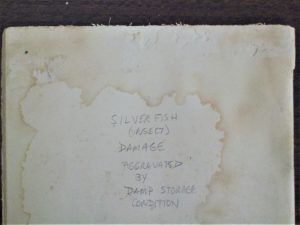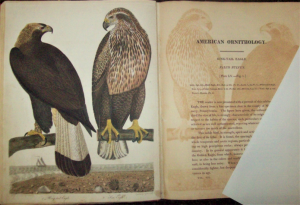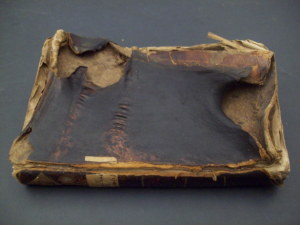by Michael Lear, Rare Collections Librarian,
State Library of Pennsylvania
mlear@pa.gov
Preservation of Paper-Based Materials Overview
Paper-based materials are subject to damage by multiple external and internal factors. Careless handling can result in tears. Staining can occur due to contact with food and drink or other substances. Exposure to light or high temperatures and low humidity can result in fading and embrittlement and high humidity can result in foxing or mold. In addition, paper can also be affected by other materials it is in contact with through acid migration. In addition to these external conditions, paper is also subject to deterioration due to the inherent acidity or chemical instability of the paper itself. Pre-1850 paper, produced by mechanical pulping, is generally less acidic and in better condition than paper items produced between 1850 and the 1970s due to the use of acid and other chemicals in the production of paper. Acid and lignin in wood pulp causes paper to yellow and embrittle, with newspapers generally being the most susceptible. Iron gall ink used on early documents can also eat away at the paper and cause loss and embrittlement.
Preservation vs. Conservation
The aim of preservation is to maintain an item in its current state in order to prevent additional or future damage or deterioration. Conservation involves making repairs, performing chemical treatments or other restoration work. Never attempt to perform conservation work on an item, as even well-meaning attempts may result in damage. Always consult a conservator concerning conservation needs. Some things to avoid include:
- Never laminate any paper item as the heat or adhesive-based lamination process alters the original integrity of the item, is irreversible, and may eventually destroy the item inside.
- Do not use any type of tape to make repairs or attempt to remove old tape or lamination.
- Do not attempt to clean an item.
Tips for safe housing and storage of paper-based materials
Recommended storage conditions for paper materials is a stable temperature of 65 to 70 degrees F and 30-50% relative humidity year-round. If lacking the above conditions, it is imperative to at least store paper in living areas and not in attics and basements, which are too dry or humid and subject to extreme temperatures and water leaks. Store paper materials off the floor and do not store paper near sources of water, insects, heat, light, direct air flow, dust, or in wooden or particleboard cabinets due to chemical off gassing from these materials.
Example of silverfish insect damage and water staining due to this item being stored in damp conditions. Silverfish are attracted to the starch in paper.
All storage materials that are used in contact with paper-based materials that you wish to preserve should be acid and lignin free and either be buffered or unbuffered (with or without an alkaline reserve). In general, buffered materials are used for cellulose-based paper, while unbuffered materials are used for protein-based materials such as items printed on silk or written on vellum. Inert plastics such as Melinex (Polyethylene Terephthalate), polyethylene or polypropylene can also be used, especially for items of visual interest such as sheet music or seed catalogs. Avoid PVC.
Books
Specific tips for caring for books include:
- All books should be stored upright on shelving. To avoid abrasion and damage, make space for books during retrieval or re-shelving so that they are not damaged in the process. Be sure not to pull books being retrieved out by their headbands (which can damage the spine). Make sure bookends are in place to avoid books leaning over.
- Oversize books too tall or too wide for shelving upright should be stored flat taking care to stack books in such a manner that larger folios are on the bottom and smaller books are on top so that everything is properly supported. Do not over stack, as damage can occur due to abrasion, crushing and distortion.
- Unbleached, cotton twill tape can be used to secure loose book covers. Do not use tape or rubber bands. Be careful not to damage boards by securing too tightly.
- Call number flags used in books should be of acid free, 26 lb paper cut 2.5” by the length of the text block plus 1.5”. Call numbers should be written in pencil at the top of the flag and placed in the book immediately inside the cover and not among pages in order to avoid accidental tears. Alternately, slips of acid free paper can be used, but they may need to be replaced more often.
- For rare books, never place barcode or call number labels or tattle tape on these items as they damage and devalue the items. Barcodes can be placed on call number flags and tattle tape should be avoided as the adhesive metal strip can damage items through acid migration.
- Some books, especially those that have been rebound in the late nineteenth/early twentieth century, may have acidic fly leaves in direct contact with title pages and end pages. To avoid discoloration and embrittlement due to acid migration, insert custom cut pieces of buffered, acid free paper between such pages to prevent damage.
- Books illustrated with hand-colored lithographs or engravings should be interleaved (on the pages containing illustrations) with buffered, acid-free tissue paper to prevent image burn into the facing page(s).
An example of image transfer from one page to another in Alexander Wilson’s American Ornithology, 1808-1825. The original tissue guards used to prevent this have been lost or removed. A new sheet of acid-free paper has been inserted to prevent further transfer, though one could argue that such transfer is inherent to the piece and attests to its authenticity.
- Valuable or extremely fragile books should be stored in custom-fitted phase boxes. In cases where time and cost is an issue, leather covered books, especially those with red rot, can be covered with a custom-fitted Melinex book covers to prevent transfer to adjacent materials. Cloth-covered books needing special protection can be covered with buffered acid free paper if not in contact with adjacent leather bindings. Do not use tape to construct or secure book covers.
- Pamphlets should be stored individually in pamphlet folders or envelopes and not placed on the shelf loose as they may be damaged by surrounding materials, especially through shelving and re-shelving.
Photograph of a severely water-damaged book where the leather has shrunk away from the boards.
Other paper-based materials
Manuscripts
- Manuscript material such as correspondence, financial and legal documents, ephemera, minutes, diaries, etc should be stored in buffered, acid-free folders and boxes. Particularly acidic materials within a folder should be interleaved with 20 lb buffered, acid-free paper to prevent acid migration to adjoining materials.
- Any materials that do not fully fit into folders should be stored in flat boxes or file drawers.
- Since paper may separate at folds in time, unfold larger items and store in flat boxes or flat drawers as necessary.
- If using legal-sized boxes, use all legal-size folders in the box to prevent shifting of materials even if other folders contain letter size materials.
- Use a spacer to fill in a partially filled box to prevent curling of materials. Crease pre-scored folders to accommodate the thickness of materials in each folder. Do not overstuff folders or boxes.
Newspapers
- Loose newspapers should be stored in flat document boxes and interleaved with buffered, acid-free tissue or 20 lb paper to prevent acid migration and to provide a support in handling individual issues. Bound newspapers should be stored flat in the same manner as oversized books.
Newspaper clippings
- Loose newspaper clippings can be preservation photocopied on buffered, acid free paper and the originals discarded if preserving the information is the primary concern. Be sure to record any known information on the photocopy concerning the name of the newspaper, date, and column location (if known). Be sure to capture all parts of the clipping(s) in photocopies.
- In some other cases it may be desirable to retain the original news clippings. Clippings may be retained but should be placed in an enclosure such as a buffered, acid-free envelope to prevent acid migration to adjoining materials.
Scrapbooks
- Scrapbooks should be stored flat on a shelf or in a box. Since scrapbook pages were often made with poor quality acidic material, pages should be interleaved with buffered, acid free tissue or 20 lb paper (if this does not stress the binding) in order to prevent acid-migration between pages and facing material.
- Since mounted materials often come loose from their pages, it is recommended that loose materials be placed in a folder or envelope labeled with the page number or leaf they came from in order to maintain the integrity of the scrapbook and how it was organized and presented. Consult a conservator concerning whether it is advisable to remount loose items.
Oversize Materials – maps, prints posters, drawings, architectural plans
- Flat file drawer storage or appropriately sized oversized flat manuscript boxes should be used depending on the size and thickness of oversize materials.
- Large size, buffered acid-free folders can be used to house groups of materials where appropriate, taking care not to overload the folder so that it cannot be easily handled.
- Materials should be interleaved using buffered, acid free tissue paper and particular care must be paid to charcoal or pastel drawings to avoid smudges and loss of pigment.
- Particularly fragile oversized materials may be stored in a large Melinex sleeve, with the exception of charcoal and pastel drawings which may be damaged by static electricity pulling the media away from the paper.
- When housing materials in Melinex, a buffered, acid free piece of tissue can be inserted as a backer to mitigate deterioration due to acidic gasses being trapped in the enclosure. If the piece is particularly fragile, use acid-free 20 lb paper or card stock to support the item while handling.
- Do not overstuff drawers or boxes.
- There is some debate on using buffered folders for architectural plans, especially blueprints (those with a blue background and white lines). In these cases, use unbuffered folders or unbuffered tissue or Melinex as a barrier between the folder and blueprints. It is recommended that different types of architectural plans not be stored together as diazo process plans (those with white backgrounds and blue lines) can damage blueprints they are in contact with.
- Extremely oversized materials that cannot otherwise be stored flat will have to be rolled around an acid free tube. Acid-free material should also be used as backer to protect the rolled item. The tube should then be covered in unbleached cotton muslin or placed inside a larger tube to further protect the item.
Framed Items
Because historic prints, broadsides and other documents were commonly framed using acidic materials, such as poor-quality mats and wooden backer boards, all materials in frames should be unframed and stored in flat file drawers or in boxes the same as other loose documents. This saves storage space and preserves these items more effectively. Alternatively, items can be stored in frames if reframed with acid-free materials and not exposed to light in their storage environment.
 Example of a board used as a backer to a framed item. The acidity of the board has resulted in brittleness as seen by the broken corner. This same acidity has also made the board susceptible to discoloring and could have potentially migrated to damage the item inside the frame.
Example of a board used as a backer to a framed item. The acidity of the board has resulted in brittleness as seen by the broken corner. This same acidity has also made the board susceptible to discoloring and could have potentially migrated to damage the item inside the frame.
Exhibiting
If you desire to exhibit paper-based items, it is recommended that you have a copy or scanned facsimile made of the original since the original can be damaged by light. If you must display the original, use UV filtering glass in the frame and acid-free mats and backer boards. Limit the amount of exposure time (no more than three months) and keep away from direct and intense sources of light, both sunlight and artificial light (especially fluorescent). Also avoid sources of heat, moisture, and direct air flow. Do not mount materials using adhesives. While non adhesive (not adhered to the item itself) archival corners might be used, relying on the pressure on the item inside a mat and frame to hold it in place is preferable.
Resources consulted
Conn, D., & Walus, D. (2014). Paper objects and books. In Harvey, R., & Mahard, M.R. (Eds.), The preservation management handbook : A 21st century guide for libraries, archives, and museums (pp. 147-181). Lanham, MD : Rowman and Littlefield.
Harvey, R., & Mahard, M.R. (2014). The preservation management handbook : A 21st century guide for libraries, archives, and museums. Lanham, MD : Rowman and Littlefield.
Northeast Document Conservation Center (2015). Preservation 101 Session 4 : Caring for paper collections. Retrieved from https://www.nedcc.org/preservation101/session-4
Northeast Document Conservation Center (2012). NEDCC Preservation Leaflet 4.1 : Storage and handling for books and artifacts on paper. Retrieved from https://www.nedcc.org/free-resources/preservation-leaflets/overview
Northeast Document Conservation Center (2012). NEDCC Preservation Leaflet 4.4 : Storage enclosures books and artifacts on paper. Retrieved from https://www.nedcc.org/free-resources/preservation-leaflets/overview
Northeast Document Conservation Center (2012). NEDCC Preservation Leaflet 4.5 : Protecting books with custom-fitted boxes. Retrieved from https://www.nedcc.org/free-resources/preservation-leaflets/overview
Northeast Document Conservation Center (2012). NEDCC Preservation Leaflet 4.8 : Polyester film book jacket. Retrieved from https://www.nedcc.org/free-resources/preservation- leaflets/overview
Northeast Document Conservation Center (2012). NEDCC Preservation Leaflet 4.9 : Storage solutions for oversized paper artifacts. Retrieved from https://www.nedcc.org/free-resources/preservation-leaflets/overview
Ritzenthaler, M.L. (1993). Preserving archives and manuscripts. (2nd ed.). Chicago: Society of American Archivists.





